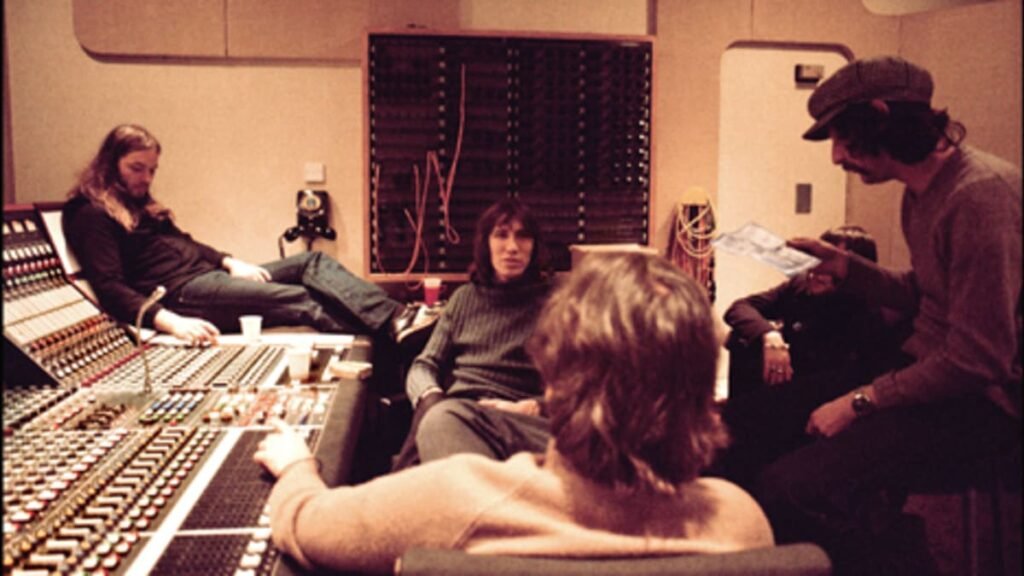In the late 1970s, during a particularly intense recording session for The Wall, Roger Waters, frustrated with the band’s lack of focus, famously spit on a disruptive fan. This shocking incident symbolized not only the tension within Pink Floyd but also the growing chasm between Waters and his bandmates, foreshadowing his eventual departure.
Brief Overview
Pink Floyd, a pioneering force in progressive rock, reshaped the music landscape with their innovative soundscapes, philosophical lyrics, and groundbreaking live performances. The band’s success, marked by iconic albums like The Dark Side of the Moon and Wish You Were Here, was significantly shaped by Roger Waters’ creative vision. However, as the band reached the peak of their artistic achievements, internal conflicts began to surface. Waters’ increasing control over the band’s direction clashed with the creative inputs of his fellow members, ultimately leading to his departure in 1985. This split not only marked the end of an era for Pink Floyd but also left an indelible impact on the music world, highlighting the complex dynamics of collaboration in artistic endeavors.
Early Dynamics of Pink Floyd

Pink Floyd’s journey began in the mid-1960s, when architecture students Roger Waters, Nick Mason, and Richard Wright met at London’s Regent Street Polytechnic. They initially formed a band called Sigma 6, performing covers of popular R&B songs. The addition of Syd Barrett, a charismatic and innovative guitarist, in 1965, marked a pivotal moment. Barrett’s unique approach to music and his knack for writing whimsical, surreal lyrics transformed the group into Pink Floyd, named after two blues musicians, Pink Anderson and Floyd Council.
The band quickly gained a following in London’s underground music scene, renowned for their extended improvisations and psychedelic light shows. Their debut album, The Piper at the Gates of Dawn (1967), largely written by Barrett, was a critical and commercial success, establishing them as pioneers of psychedelic rock. However, Barrett’s deteriorating mental health led to his departure from the band in 1968, leaving a significant void that Roger Waters began to fill.
Role of Roger Waters
With Barrett’s exit, Roger Waters stepped up as the primary creative force behind Pink Floyd. Initially the band’s bassist, Waters’ role expanded to principal lyricist and conceptual leader. His introspective and often dark lyrical themes began to shape the band’s identity, steering them towards more ambitious and conceptually driven projects.
Waters’ influence became evident with albums like A Saucerful of Secrets (1968) and Ummagumma (1969), where the band’s music took on a more experimental and progressive direction. His ability to blend personal and political commentary with complex soundscapes became a hallmark of Pink Floyd’s work. Waters’ vision was instrumental in the creation of their seminal albums, The Dark Side of the Moon (1973) and Wish You Were Here (1975), both of which explored themes of existentialism, mental illness, and the human condition. These albums not only solidified Pink Floyd’s place in rock history but also highlighted Waters’ profound impact on their sound and lyrical depth.
Creative Differences

As Pink Floyd progressed from their early psychedelic roots, their music evolved into more complex and sophisticated compositions. This evolution was significantly driven by Roger Waters, whose vision began to dominate the band’s direction. Waters’ introspective and often bleak thematic concerns, focusing on isolation, war, and existential angst, started to shape the band’s identity. While this shift brought critical acclaim and commercial success, it also highlighted divergent artistic philosophies within the band.
David Gilmour, who had become the band’s lead guitarist and co-vocalist, preferred a more collaborative approach that balanced the musical and lyrical contributions among all members. Gilmour’s style leaned towards melodic guitar solos and a more expansive sound, contrasting with Waters’ increasingly narrative-driven and concept-heavy direction. Richard Wright and Nick Mason, while integral to the band’s sound, found themselves increasingly sidelined as Waters’ control tightened. This growing disparity set the stage for creative tensions that would erupt during the creation of some of their most ambitious projects.
Concept Albums and Conflicts
The making of The Wall (1979) was a pivotal period that underscored the creative differences within Pink Floyd. Conceived almost entirely by Roger Waters, The Wall was a rock opera that explored themes of abandonment, isolation, and the construction of psychological barriers. While the album became one of Pink Floyd’s most successful and critically acclaimed works, its creation was fraught with tension. Waters’ authoritarian approach to the project led to significant friction, particularly with Richard Wright, who was eventually fired from the band during the sessions, although he was retained as a salaried musician for the subsequent tour.
Following The Wall, the band embarked on the creation of The Final Cut (1983), an album even more dominated by Waters. Initially conceived as a soundtrack for The Wall film, it evolved into a standalone project addressing Waters’ reflections on war and the disillusionment of the post-war generation. The album’s recording process was marked by intense conflict. Waters’ insistence on his vision led to further alienation of his bandmates, particularly Gilmour, who felt his musical contributions were being marginalized.
Gilmour and Mason were unhappy with the direction and working conditions, feeling that the band had become a vehicle solely for Waters’ personal artistic expression. Gilmour’s frustration was evident, as he later described The Final Cut as essentially a Roger Waters solo album in all but name. This period saw the complete erosion of the collaborative spirit that had once defined Pink Floyd, with Waters’ dominance creating an environment of discord and dissatisfaction.
Personal Tensions

The interpersonal dynamics within Pink Floyd were complex and often fraught with tension, particularly between Roger Waters and David Gilmour. While the band initially thrived on their collaborative efforts, the balance began to shift as Waters’ creative vision grew more dominant. This imbalance created an environment ripe for conflict, exacerbating personal differences and straining relationships.
Roger Waters, known for his intense and often uncompromising personality, became increasingly dictatorial in his approach. His vision for the band’s music and themes was clear and compelling, but his methods left little room for input from other members. David Gilmour, in contrast, valued a more democratic process and was frustrated by Waters’ growing control. Gilmour’s contributions, especially his melodic guitar work and vocal performances, were integral to Pink Floyd’s sound, and he felt marginalized as Waters pushed his own agenda.
The tensions between Waters and Gilmour were not just about creative control but also about clashing personalities. Waters’ confrontational style clashed with Gilmour’s more laid-back approach, leading to frequent disagreements. Richard Wright and Nick Mason often found themselves caught in the middle, with Wright in particular feeling increasingly alienated and eventually being pushed out during the recording of The Wall.
Public Disputes
The private tensions within Pink Floyd occasionally spilled into the public domain, highlighting the growing rift between Waters and his bandmates. One notable instance was during the promotion of The Wall tour in 1980. Waters, dissatisfied with the band’s performances and the audience’s reaction, suggested that they build a physical wall between the band and the audience during concerts, a concept that became a central feature of the live shows. Gilmour and Mason were skeptical, but Waters’ vision prevailed, symbolizing the increasing divide within the band.
Another significant public dispute occurred during the making of The Final Cut. By this point, Waters had taken almost complete control of the project, relegating Gilmour and Mason to the roles of session musicians. Gilmour openly criticized the album, describing it as “pretty much Roger’s solo album,” and expressed frustration at the lack of collaboration. This public acknowledgment of their internal discord underscored the deep divisions within the band.
The acrimony reached its peak when Waters announced his departure from Pink Floyd in 1985, followed by a bitter legal battle over the rights to the band’s name and music. Waters attempted to dissolve the band, believing that Pink Floyd could not continue without him. Gilmour and Mason, however, disagreed and decided to carry on without Waters, leading to a protracted legal dispute that further strained their relationship. Ultimately, Gilmour and Mason retained the right to continue under the Pink Floyd name, while Waters pursued a solo career.
Aftermath and Legacy

Following Roger Waters’ departure in 1985, Pink Floyd faced the daunting task of continuing without their primary lyricist and conceptual leader. David Gilmour and Nick Mason decided to carry on under the Pink Floyd name, bringing in keyboardist Richard Wright, who had been ousted during The Wall sessions. This decision led to a protracted legal battle with Waters, who believed that Pink Floyd should be dissolved. Ultimately, Gilmour and Mason retained the rights to the band’s name and continued to produce music.
In 1987, the reconfigured Pink Floyd released A Momentary Lapse of Reason. This album marked a significant departure from the band’s earlier work, with Gilmour taking the helm. While it retained some of the band’s signature atmospheric sound, the album leaned more towards Gilmour’s melodic sensibilities. A Momentary Lapse of Reason was commercially successful, reaching number three on the US and UK charts and spawning a successful world tour. However, it received mixed reviews, with some critics and fans noting the absence of Waters’ lyrical depth and conceptual ambition.
Pink Floyd’s next album, The Division Bell (1994), saw further refinement of their post-Waters sound. It featured more collaborative writing between Gilmour and Wright and addressed themes of communication and reconciliation. The Division Bell was well-received and also achieved commercial success, topping the charts in both the UK and the US. The accompanying tour was one of the highest-grossing of the decade, solidifying Pink Floyd’s status as a major live act even without Waters.
Waters’ Solo Career
After leaving Pink Floyd, Roger Waters embarked on a solo career that allowed him to fully explore his artistic vision. His first major solo work, The Pros and Cons of Hitch Hiking (1984), was actually conceived before his departure from Pink Floyd. The album, featuring Eric Clapton on guitar, was a deeply personal narrative exploring themes of love, fear, and dreams. Although it received mixed reviews, it demonstrated Waters’ ability to craft intricate concept albums independently.
In 1987, Waters released Radio K.A.O.S., a more accessible album that explored contemporary issues like technology and societal alienation. The album’s narrative followed a young man with special abilities who communicates through radio waves, reflecting Waters’ continued interest in concept-driven projects. While it did not achieve the commercial success of Pink Floyd’s works, it was praised for its ambition and thematic cohesion.
Waters’ most acclaimed solo work, Amused to Death (1992), was a scathing critique of media and consumer culture. Drawing on influences from George Orwell and Aldous Huxley, the album examined the dehumanizing effects of television and mass media. Amused to Death received positive reviews and is often considered Waters’ solo magnum opus, highlighting his enduring talent for combining sharp social commentary with complex musical compositions.
Long-Term Impact
Roger Waters’ departure from Pink Floyd had a profound and lasting impact on the band’s legacy and on rock music as a whole. The split highlighted the complexities of maintaining a collaborative creative process within a band, especially one with such strong individual personalities. Waters’ influence on Pink Floyd’s sound and themes was undeniable, and his absence created a noticeable shift in the band’s direction.
The post-Waters era of Pink Floyd demonstrated the band’s resilience and ability to adapt. Gilmour, Mason, and Wright successfully carried on the Pink Floyd legacy, albeit with a different sound and approach. Their continued success proved that Pink Floyd’s appeal extended beyond any single member, although the contrast between the Waters-led and post-Waters albums remains a topic of debate among fans and critics.
Waters’ solo career further cemented his reputation as a visionary artist. His ability to tackle complex social and political issues through music influenced many contemporary musicians and reinforced the role of rock music as a medium for profound artistic expression.
In the broader context of rock music, Waters’ departure from Pink Floyd is often seen as a pivotal moment that underscored the tension between individual artistic control and collaborative creativity. It serves as a case study in how bands navigate internal conflicts and the impact those conflicts can have on their musical output and legacy. Waters’ contributions to Pink Floyd and his subsequent solo work continue to inspire and provoke, ensuring his lasting influence on the genre.
